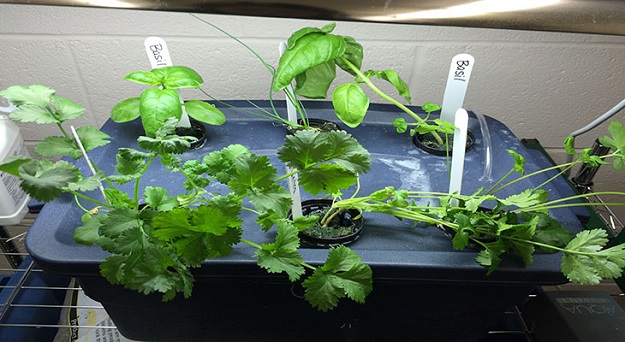
A passive hydroponics system will use some sort of mechanism to suspend a plant allowing the roots to hang into the nutrient solution. This method will be moderately successful with the main disadvantage being, how you support plants as they continue to grow.
A simple system is to fill a 5-gallon cooler with water, mix in an appropriate amount of hydroponic nutrient and float your plant in the cooler in a piece of Styrofoam with a hole for the plant cut into the middle. Just be sure not to sink the plant too low or it will drown.
This is a simple and effective set up except when the plant grows it will eventually become large enough that it will overbalance and sink like a ship in a storm if it is not supported. Still, this type of set up can be ideal for something like lettuce or herbs.
There are 5 basic requirements plants need to survive:
- Light
- Water
- Oxygen
- The correct temperature
- Mineral salts (nutrients)
Keeping these in mind, I would include an aquarium air bubbler in the cooler to add oxygen and, of course, a good light source.
Aquaponics can also be classified as a passive hydroponics system. This method uses a working aquarium, with fish, as the container and nutrient solution into which you suspend a plant’s roots. It already has an aquarium bubbler supplying oxygen and with a good light source it sounds like the perfect way to grow a vegetable plant…. the 4 basic requirements of plants are met….
The theory is that fish eat and excrete nutrient-rich matter on which a plant will feed and prosper. Will it work? No! You may have some small measure of success by luck alone, but this is not a viable hydroponics method.
Remember that a vegetable plant has evolved to have specific nutritional requirements – certainly different from the nutrition a water lily may need. Aquatic plants such as waterlilies have evolved to prosper in such an environment so if you wish to add plants to your aquarium, add aquatic plants, not vegetables.
Another classic passive system is to fill a jar with nutrient solution, jam the neck with a wad of cotton and then place a small plant through the cotton so the roots dangle in the water. You can then put a small aquarium bubbler into the jar for oxygen.
Larry Maki is an avid, self-taught hydroponics gardener from Connecticut with a passion for alternative types of gardening.
Related Articles & Free Email Newsletter
Hydroponics as a Supplemental Growing Method
Required Bi-Monthly Maintenance for a Complete Hydroponics System




Comment here